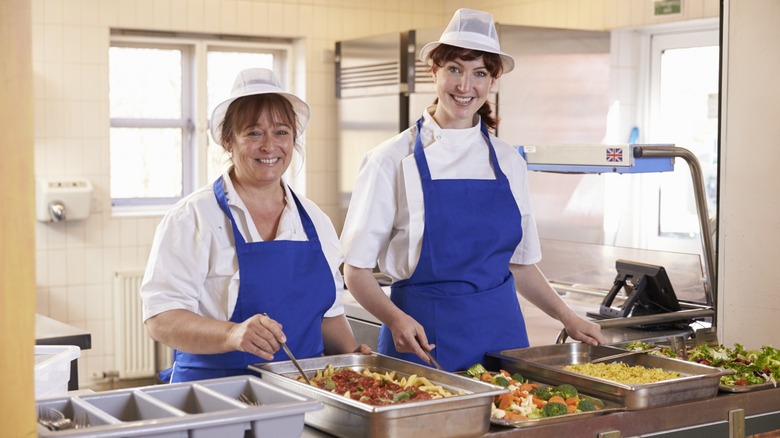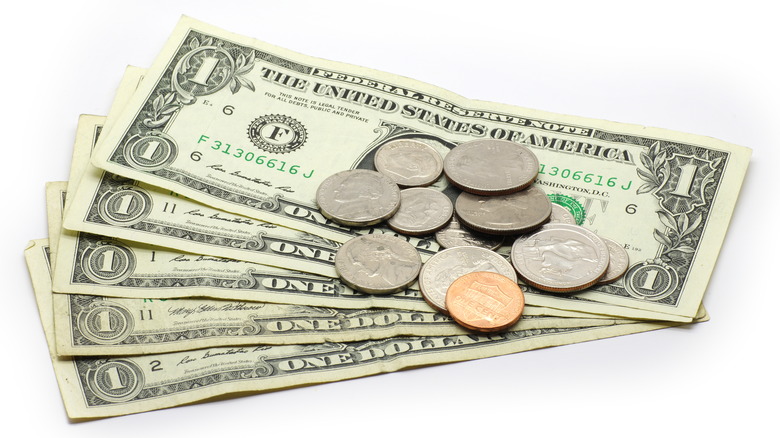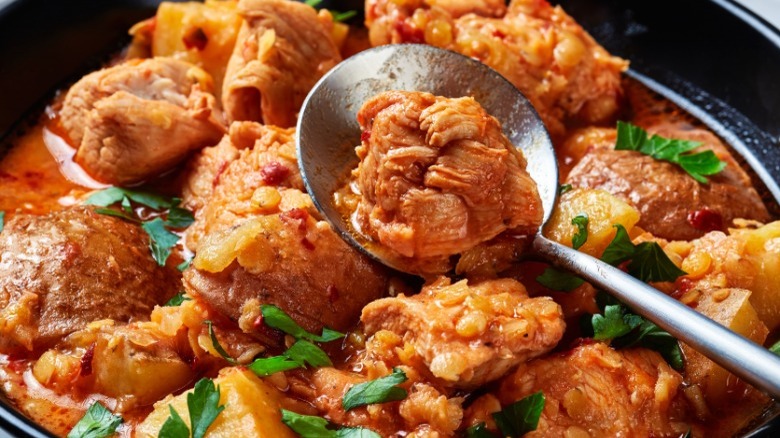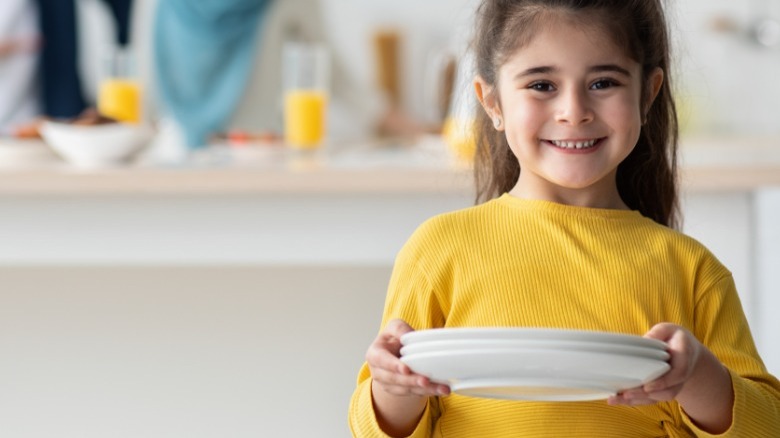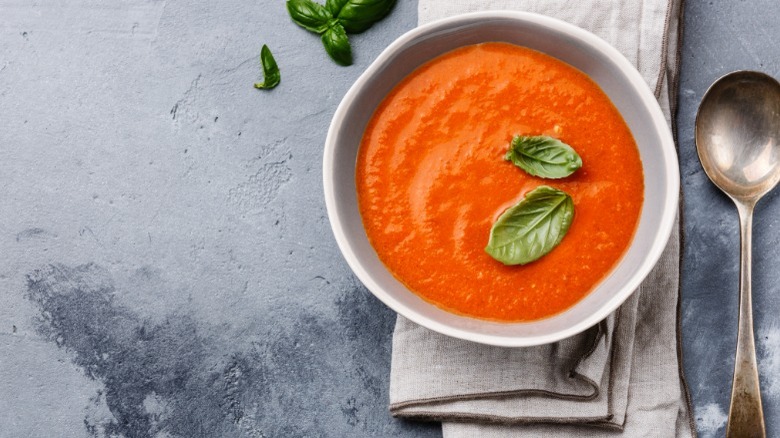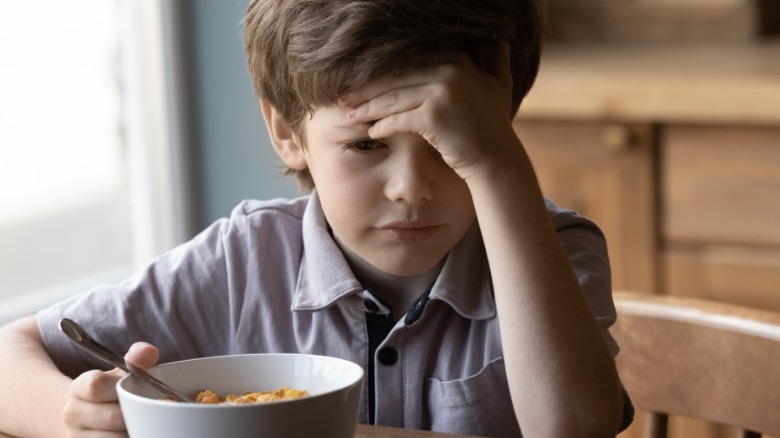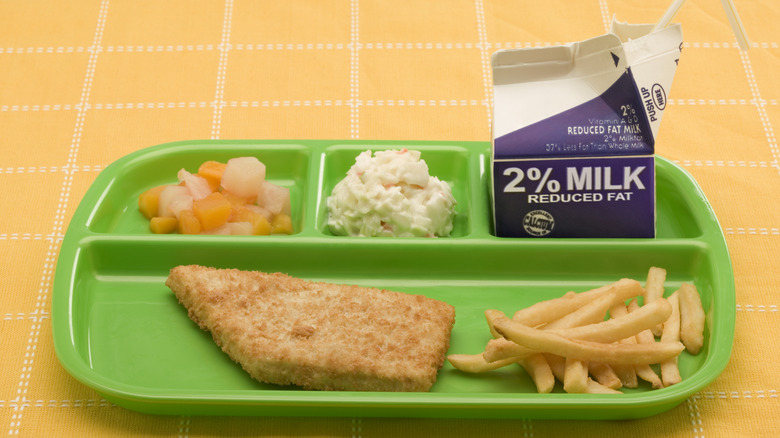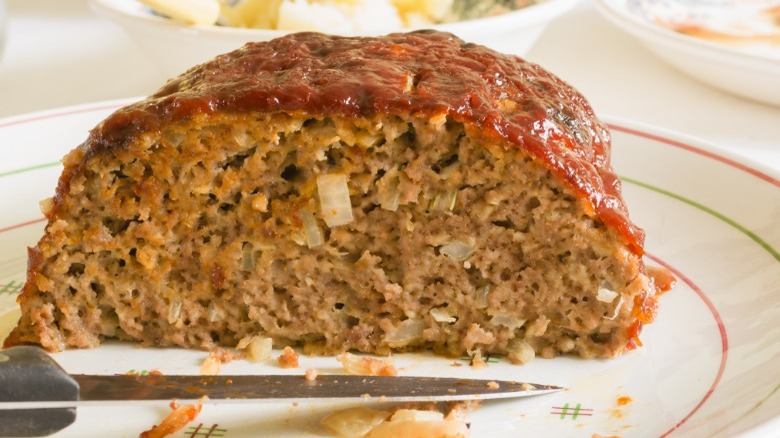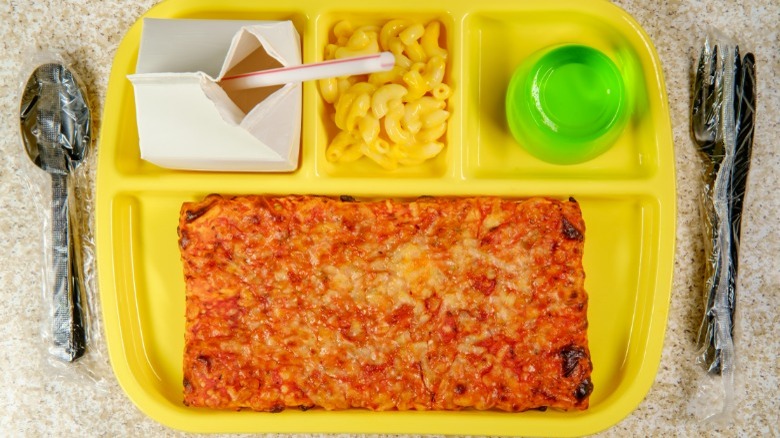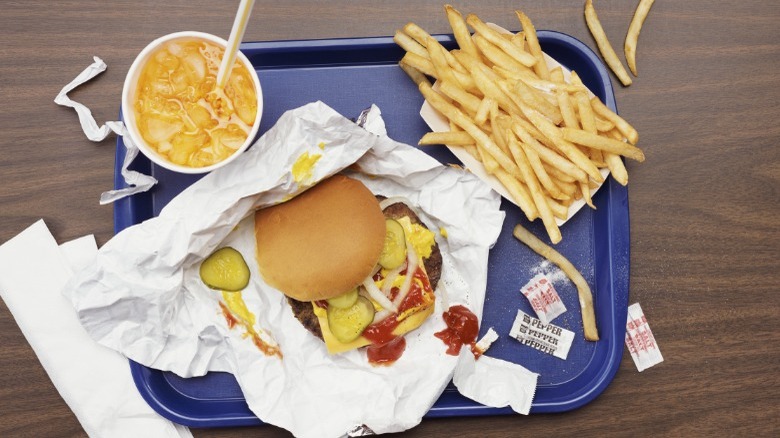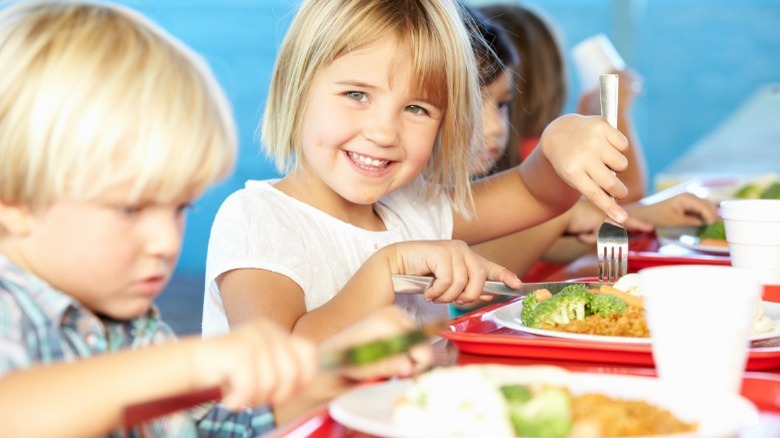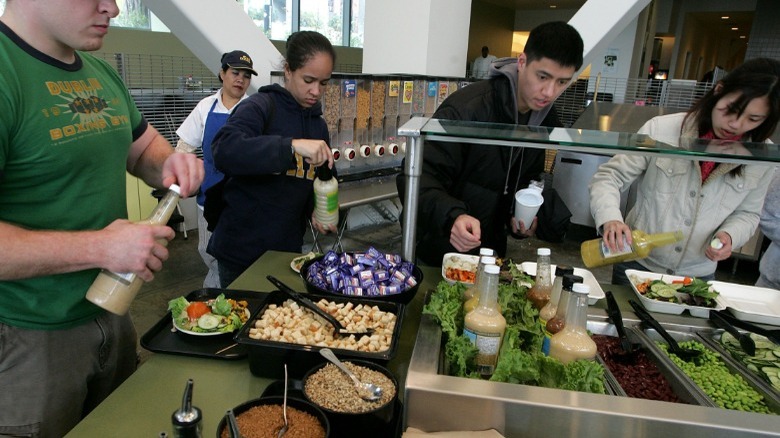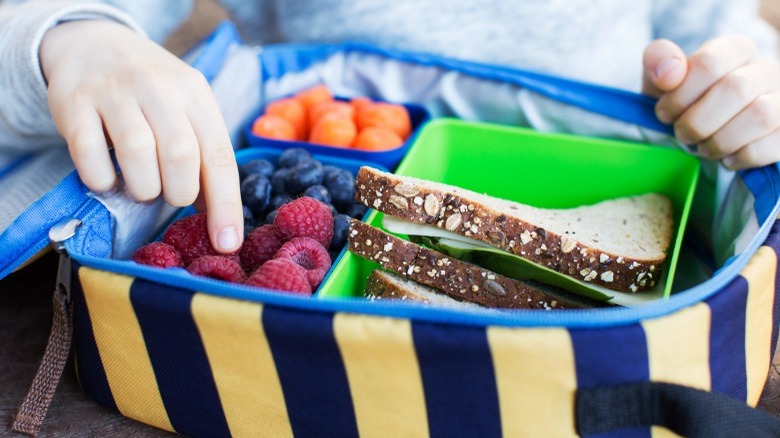12 Ways School Lunches Have Changed Over The Years
Before the first lunch lady ever held center stage inside a school cafeteria, students used to eat this midday meal at their houses or bring in food, unless there were other options. Walking home wasn't feasible for kids who lived many miles away, so they brought in dinner leftovers or whatever else was available. The earliest schools were small and didn't even have cafeterias, so teachers and students had to make do by eating outside or at their desks. The hour-long breaks were called nooning in some schools and were also used for recess. The first school dining halls were found in private boarding schools since these students lived on site.
At the turn of the 20th century, volunteer groups began producing and subsidizing school lunches. The first significant program was run by the New England Kitchen in 1894, headed by Ellen Richards and Edward Atkinson in Boston. Soon afterward, students attending public schools in large U.S. cities benefited from similar school lunch programs. As more and more families started sending their children long distances to school, the services expanded. The food, preparation methods, and pricing in the beginning were all quite different from what you see these days. Here are some of the most fascinating ways school lunches have changed over the past decades.
1. The prices have gone up
In 1914, the cost of a school lunch in Manhattan elementary schools was three cents, and it was just one cent in other parts of the country. At the Manhattan schools, the three cents got students hot and cold items like mashed potatoes, rice, and bread — there were negligible amounts of meat, poultry, or fish on the daily main menus. But for one cent more, students could buy a candied apple, four crackers, three figs, or a hot sausage with an extra slice of bread. Stewed prunes were also offered for a penny, but we bet that the kids were likelier to opt for two pieces of sweet chocolate or the homemade ice cream sandwiches. The cooks were paid a buck a day, and today, they might earn about $15 an hour.
Three cents won't buy you anything anymore, and it's hardly surprising that the average cost of school lunches has increased dramatically over the past 100+ years. As of 2023, the typical price for an elementary school lunch is about $2.75, and for high schools, it's $3. Students who buy breakfast at schools pay a little over half those amounts for each meal. And they don't hand money to the lunch ladies — in most cases, families deposit money into lunch accounts, and it gets withdrawn automatically when kids swipe their cards. The exact prices are set by local school districts, and reduced or free lunches are available for families who qualify.
2. School lunch was a community affair
In the 1900s, teachers might have asked children to bring lunch ingredients to school, and whatever was usable was combined into a large pot to make a hearty stew. There could have been meat bones, potatoes, vegetables, and so forth. The pots would then be placed on top of the school's heater to cook. Students and teachers might have also contributed things like cold pancakes, hard-boiled eggs, fruit, and cake. But imagine how hard it would be to study while smelling the delicious aromas of your lunch being prepared right next to your seat.
Kids who could walk home for lunch wouldn't need to contribute, but those who stayed basically had potlucks. But during the Depression and other hard times, there may have been little food for the classes to share — children and teachers may have had to sit through lessons with growling stomachs. The U.S. government took action in the 1930s and began buying surplus food from farmers. This both provided students with hot lunches and helped struggling farms stay solvent. Finally, in 1946, the National School Lunch Program was introduced, and things changed for the better.
3. Students served, cleaned up, and cooked
Back in the days of three-cent lunches, students pitched in to help serve the meals. In Manhattan, these volunteers even wore shiny white aprons and caps and, if they handled bread, gloves. The organizers split the volunteers into shifts, so the children worked on alternate days. And by the way, it wasn't all about serving because they also had to do the dishes.
At some schools, students were treated to lunch selections prepared by students. At the Trade School for Girls in Boston, students in the domestic science program cooked and baked things like stuffed tomatoes and brown bread that were served at lunchtime. This reads like a great idea in theory, unless the food the novice cooks made was burnt or otherwise not palatable. Today, you might see students who take school cooking classes distributing things like brownies and other foods to classmates as part of the programs. They might also volunteer to cook, serve, and clean up at school fundraisers.
4. Soup was usually on the menu
Soup is often hearty and filling and is also easy to make — nothing satisfies in quite the same way when you're chilled to the bone. In the earliest days of school lunches, it wasn't unusual for schools to serve up vegetable-based soups three or more days a week, with choices like tomato, potato, and lentil.
You won't find soup on every school cafeteria menu nowadays, possibly because it can be so messy to serve and clean up. We researched for specifics, but many school districts require you to log in to see the menu. We were able to see one for DeKalb County School District in Georgia, though. There were no soups listed on the elementary, middle, and high school menus. A menu from New Jersey's Evesham Township School District indicated tomato soup was only served one day in March 2023.
It is possible to send a child to school with soup in a Thermos, but reheating it is a problem unless there's access to a microwave: After a few hours, the soup will be lukewarm but not piping hot. And does anyone really want to deal with spilled soup in backpacks and on books and clothes? It's safer to serve soup at home on the weekends or for breakfast and dinner instead.
5. There were strange recipes in the 1930s
When school cafeteria lunches were first served, children were given milk with each meal. This is still done today, but some of the menu items from the 1930s were strange, to say the least. The organizers were still figuring out how to provide adequate nutrition, but sometimes the results were a bit off. Bread-and-butter sandwiches were popular, but a stranger example is a grated carrot sandwich that wasn't fooling any child who hated vegetables. A menu might also have included cracked-wheat chowder, codfish, and creamed liver.
Yep, that last one made us a little nauseous, too.
Here are two more strange lunch items that might make you lose your appetite: a chopped cabbage sandwich, and peanut butter and tomato soup. And no, that last one isn't a typo. Peanut butter and tomato soup was made with 12 quarts of canned tomatoes, onions, and 3 pounds of peanut butter. The final color and consistency are anyone's guess, but that recipe can certainly serve a crowd of hungry kids.
6. How federal programs improved school lunches
Even though public schools had federally funded lunch programs during the 1940s, supply chain problems were an issue. Fresh produce would rot during transport because of timing or because they weren't properly packed and stored, and World War II only exacerbated the issue. No major changes were implemented until the U.S. won the war and President Harry Truman approved the National School Lunch Act. He signed this into law in 1946. The goals of the Act were to improve nutrition and to standardize menus. It has evolved over the years and continues to benefit public and nonprofit private schools.
Three additional programs were approved in the 1960s: the School Breakfast Program, the Special Milk Program, and the Summer Food Service Program. These provide low-cost or free food and milk to qualifying students. The Summer Food Service Program also led to the establishment of the Child and Adult Care Food Program, which helps daycare centers, homeless centers, and daycare homes.
7. The menus only featured heavy foods
A lunch heavy in carbs and fat makes most people sleepy, and schoolchildren are no exception. This is what many of the first hot lunches featured, and besides the post-lunch fatigue, the children were not benefiting from balanced meals. In the 1940s, school cafeteria menu items included things like creamed chipped beef, cornmeal pudding, and scrapple, with less focus on healthier foods. You can now find nutrition information for school lunches online, but back then, who knew how much carbs, fat, sodium, and sugar those kids were consuming?
There's nothing wrong with eating these foods in moderation, but there needs to be a balance. In the 1940s, there just weren't enough lean proteins, fruits, or vegetables plated up on children's cafeteria plates. But things became less dense and more balanced and colorful in the 1950s. Private food companies entered the field and introduced cold foods like sandwiches and salads. Miniature dinners featuring a large portion of meat, a side of major carbs, and sweets for dessert were soon outdated.
8. Pizza showed up in the '60s
School cafeteria lunch menus in the early 1960s contained standard white-bread ingredients like peanut butter, fish sticks, and mashed potatoes. Most people will eat these without thinking, but what about a little bit of fire and flavor? Pizza was introduced in the '60s, and kids all over the country cheered. It wasn't ordered from the pizzeria down the street, though — it was usually the frozen kind, cut into squares. Around the same time, Americanized versions of foods like tacos, wieners and sauerkraut, and chow mein noodles started showing up.
Finally, things had gotten a bit more interesting for students and teachers. But the old standbys were still there, so if you wanted Salisbury steak or salmon loaf, you were still in luck. Milk was still served with every meal, and the desserts often remained Americanized. We're sure there were few complaints, with goodies like strawberry sundaes and blackberry cobbler. There were usually servings of vegetables and fruits, too, but nothing too far off the beaten path.
9. Fast food took over menus
Starting in the 1970s, fast foods made their way into school cafeterias across the country. It makes sense because the food was cheap and the kids loved it ... who wants to get the salmon loaf when there are cheeseburgers on the menu? Soon enough, there were plenty of burgers, greasy fries, and chicken nuggets being served up en masse to hungry kids. And once that bridge was crossed, candy bars, chips, and other sweet and salty snack food followed, via food service companies and vending machines.
Federal nutrition standards weakened as this was happening, and more and more children and adults turned to these foods. Nutritionists were not happy with this development and were further miffed in 1979 when new USDA guidelines greatly relaxed the nutritional requirements for school lunches. Nutritionists were dealt another blow when the Reagan administration attempted to classify ketchup as a vegetable in the 1980s; apparently, schools were trying to get away with serving one real vegetable instead of two on the daily menus. Today, you'll still see plenty of fast food-like offerings on school menus, but they no longer take precedence.
10. Nutritious lunches made a strong comeback
Companies like McDonald's that partnered with school districts brought in needed funds, so administrators were in a quandary when it came to budgets vs. nutrition. In the mid-2000s, more than 50% of schools in the U.S. sold fast food lunches and unhealthy vending machine snacks. A few healthy foods like fresh fruits and veggies and grilled chicken were introduced, but the real change didn't come until 2010. That's when President Barack Obama signed the Healthy Hunger-Free Kids Act and first lady Michele Obama established her Let's Move program.
Because of these and other cultural changes, today's students are offered more lean proteins and low-fat options that are designed to be appealing. So instead of only full-fat hot dogs and burgers, there might be turkey dogs and turkey burgers on the menus. Some schools also have salad bars and seasonal vegetables, too. And since school lunch is a huge business, companies that want to stay in the game can either follow suit or be replaced by more forward-thinking ones.
11. How have college cafeterias evolved?
The first college cafeterias were like their grade-school cousins — self-operated, without a lot of variety. These institutional-looking facilities served food that lived up to that description, too. But after the 1980s, increased numbers of contracted food companies were in charge, and students and staff members had much more to choose from: Whereas the campus dining industry earned $1.89 billion in profits in 1972, the number is around ten times that now. And with so many nearby and on-site restaurants and delivery services, the competition for student meals is tougher than ever. These companies do what they can to make their options more appealing, and flexible student meal plans often allow students to buy meals from on-site fast food and specialty restaurants and cafeterias.
College students should consider themselves lucky because few adults are bombarded with this many meal options on any given day. West Chester University has a huge food court where students can order customized rice bowls, Italian specialties, and full entrees with all the trimmings. There's also a sushi restaurant, a Chick-fil-A, salads, and sandwiches. UCLA Dining Services has two eat-in restaurants with menu items like Peruvian-style beef, plus seven takeout restaurants. That's some selection — we're not even sure if you can find meatloaf or peanut butter and jelly on these campuses unless it's homemade.
12. Lunchboxes have changed, too
There's no point in bringing lunch to school if it goes bad during the time after it's packed and before that first bite. The original lunch pails are thought to have been popularized in the 1880s when men started taking this midday meal to work — they could be seen carrying them while walking on the streets and sidewalks. These pails would generally have inner trays, cups, and tight lids. But once children started taking their lunches to school, they were usually given used biscuit or tobacco tins. In 1902, the first product made for this purpose was introduced and soon became popular.
This first kids' school lunch box looked like a picnic basket, made from metal. It kept the food fresh, but it couldn't have been that exciting for little ones. But with the emergence of television and movies, popular characters like the Lone Ranger started appearing on lunch boxes, and, eventually, embossed designs gave them three-dimensional appearances. Soft lunchboxes are now the norm, and icepacks go inside to keep the food and drink chilled. The exteriors have changed over the years, too, featuring the likes of Disney princesses, Scooby-Doo, and a never-ending variety of colors and patterns.
